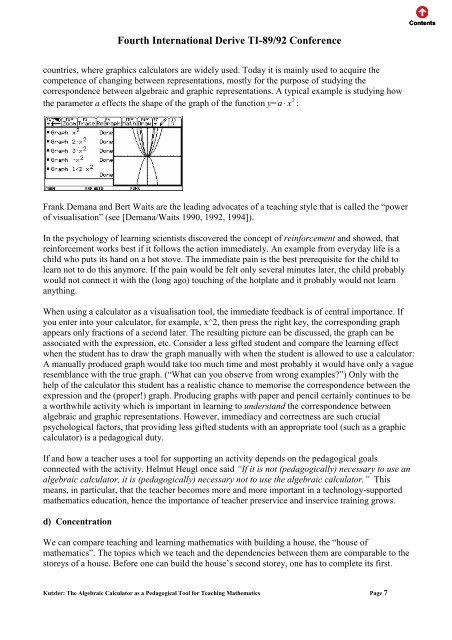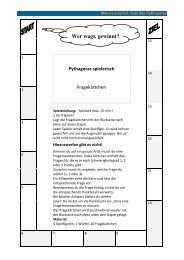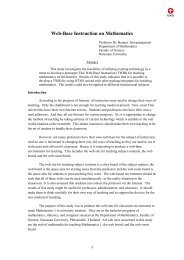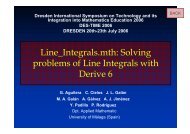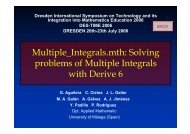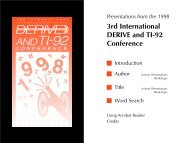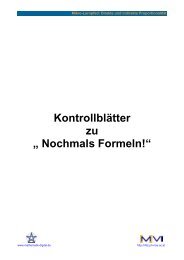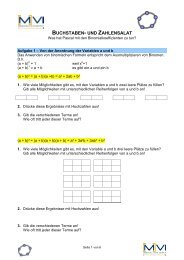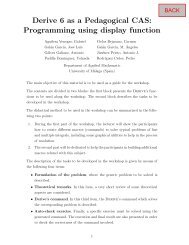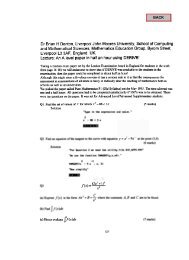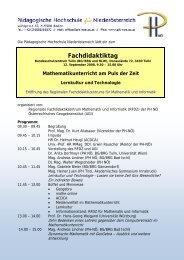The Algebraic Calculator as a Pedagogical Tool for Teaching ...
The Algebraic Calculator as a Pedagogical Tool for Teaching ...
The Algebraic Calculator as a Pedagogical Tool for Teaching ...
Create successful ePaper yourself
Turn your PDF publications into a flip-book with our unique Google optimized e-Paper software.
Fourth International Derive TI-89/92 Conference<br />
countries, where graphics calculators are widely used. Today it is mainly used to acquire the<br />
competence of changing between representations, mostly <strong>for</strong> the purpose of studying the<br />
correspondence between algebraic and graphic representations. A typical example is studying how<br />
2<br />
the parameter a effects the shape of the graph of the function y= a⋅ x :<br />
Frank Demana and Bert Waits are the leading advocates of a teaching style that is called the “power<br />
of visualisation” (see [Demana/Waits 1990, 1992, 1994]).<br />
In the psychology of learning scientists discovered the concept of rein<strong>for</strong>cement and showed, that<br />
rein<strong>for</strong>cement works best if it follows the action immediately. An example from everyday life is a<br />
child who puts its hand on a hot stove. <strong>The</strong> immediate pain is the best prerequisite <strong>for</strong> the child to<br />
learn not to do this anymore. If the pain would be felt only several minutes later, the child probably<br />
would not connect it with the (long ago) touching of the hotplate and it probably would not learn<br />
anything.<br />
When using a calculator <strong>as</strong> a visualisation tool, the immediate feedback is of central importance. If<br />
you enter into your calculator, <strong>for</strong> example, x^2, then press the right key, the corresponding graph<br />
appears only fractions of a second later. <strong>The</strong> resulting picture can be discussed, the graph can be<br />
<strong>as</strong>sociated with the expression, etc. Consider a less gifted student and compare the learning effect<br />
when the student h<strong>as</strong> to draw the graph manually with when the student is allowed to use a calculator:<br />
A manually produced graph would take too much time and most probably it would have only a vague<br />
resemblance with the true graph. (“What can you observe from wrong examples?”) Only with the<br />
help of the calculator this student h<strong>as</strong> a realistic chance to memorise the correspondence between the<br />
expression and the (proper!) graph. Producing graphs with paper and pencil certainly continues to be<br />
a worthwhile activity which is important in learning to understand the correspondence between<br />
algebraic and graphic representations. However, immediacy and correctness are such crucial<br />
psychological factors, that providing less gifted students with an appropriate tool (such <strong>as</strong> a graphic<br />
calculator) is a pedagogical duty.<br />
If and how a teacher uses a tool <strong>for</strong> supporting an activity depends on the pedagogical goals<br />
connected with the activity. Helmut Heugl once said “If it is not (pedagogically) necessary to use an<br />
algebraic calculator, it is (pedagogically) necessary not to use the algebraic calculator.” This<br />
means, in particular, that the teacher becomes more and more important in a technology-supported<br />
mathematics education, hence the importance of teacher preservice and inservice training grows.<br />
d) Concentration<br />
We can compare teaching and learning mathematics with building a house, the “house of<br />
mathematics”. <strong>The</strong> topics which we teach and the dependencies between them are comparable to the<br />
storeys of a house. Be<strong>for</strong>e one can build the house’s second storey, one h<strong>as</strong> to complete its first.<br />
Kutzler: <strong>The</strong> <strong>Algebraic</strong> <strong>Calculator</strong> <strong>as</strong> a <strong>Pedagogical</strong> <strong>Tool</strong> <strong>for</strong> <strong>Teaching</strong> Mathematics Page 7


